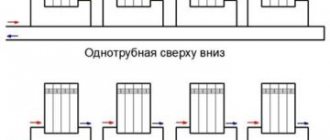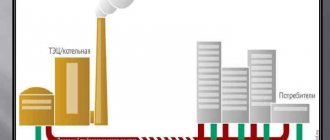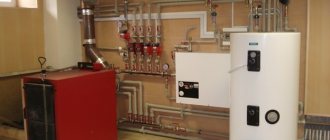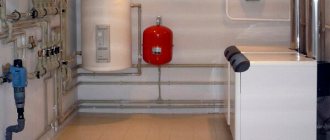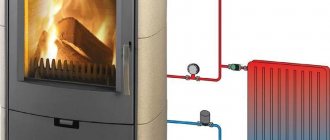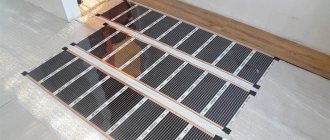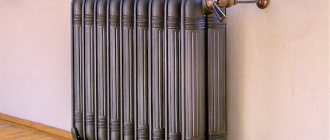During operation, coolant leaks may occur from the heating system circuit. After the elevator, the return line will also be counted. Logbook for recording instrumentation, issuing work permits, operational records, recording defects identified during inspection of installations and networks, testing knowledge, as well as briefings. Diagram of a heating unit Adjustment of the coolant supply is carried out by the elevator heating units of the house. How do heating points work in apartment buildings?
The hot water supply is made up from the cold water supply system. Water in the circulation circuit moves in a circle through circulation pumping equipment for hot water supply from the heating point to consumers and back.
Overall it's worth it!
The heating system is also a closed loop through which the coolant moves with the help of circulation pumps from the heating point to consumers and back. The project budget is millions.
In it, it is heated by network water coming from the supply pipeline of the external network. Constant flow of hot network water is ensured by an automatic flow regulator PP. For such a unit to operate, it is necessary to have a sufficiently high power source of electricity.
ITP check
Connection options
Currently there are two main connection schemes:
- dependent - considered the simplest, therefore most often used;
- independent - gained popularity relatively recently; it is widely used in the construction of new residential areas.
Below we will look at each method in more detail to find out which solution will be the most effective for ensuring comfort and coziness in your room.
Dependent connection method
This connection option usually requires the creation of in-house heating stations, often equipped with elevators. In their mixing unit, superheated water from the external main network is mixed with the return water, which allows it to be reduced to the required temperature, usually below 100 °C. Thanks to this, the heating system inside the house is completely dependent on external heat supply.
| Advantages | The main feature of the scheme is that water enters the heating and water supply system directly from the heating main, so the costs in this case pay off in a short time:
|
| Flaws | As in any scheme, here you can find not only positive aspects, but also negative ones, among which it should be noted:
|
Connection methods:
- direct connection
; - with elevator
; - with on the jumper
; - with mounting of a pump on the supply or return
; - combined option - elevator and pump
.
Independent connection method
Experts say that this heat supply option makes it possible to reduce resource costs by almost 40%.
In today's situation with their constant rise in price, this will significantly save money in the family budget.
- The operating principle is as follows:
- connection of the heating system of subscribers is made using an additional heat exchanger;
- heating occurs thanks to two hydraulic isolated circuits - the main heating main heats the coolant of the closed internal heating network;
- in this case, no mixing of water occurs.
- The coolant circulates in the heating mechanism due to a circulation pump, which regularly supplies it through the heating elements. An independent connection scheme may provide an expansion tank with a supply of water in case of leaks. In this case, it is possible to maintain the circulation of the coolant with a certain amount of heat even in the event of a heating main failure. In fact, this means that if the supply of hot water through the heating main stops, the temperature in the heated rooms will not drop sharply for a long time.
- The scope of application of this connection method is quite wide. For example, it is used:
There is one condition - the pressure in the return must be more than 0.6 MPa.
- Advantages of the method:
- the instructions allow you to adjust the temperature;
- great energy saving effect.
- Flaws:
- high price;
- complexity of repair and maintenance work.
Comparison of schemes
- The dependent option has one important advantage - low implementation cost. An elevator unit in a small country house is easily assembled with your own hands from shut-off valves, which can be purchased in a store or on the market. The only expensive part will be the nozzle, on which the power of the elevator depends.
- An independent scheme allows you to:
- adjust the coolant temperature;
- increase the efficiency of use, bringing this level to 40%;
- Large amounts of contaminants, such as scale, sand and mineral salts, do not enter the heating system. The coolant can be purified water or antifreeze liquids.
- You can easily heat clean drinking water for hot water needs.
Advantages of the elevator
Some users argue that the elevator design is irrational, and it would be much easier to supply coolant at a lower temperature to consumers. In reality, this approach involves increasing the diameter of the main pipelines to supply colder water, which leads to additional costs.
It turns out that a high-quality design of a thermal heating unit makes it possible to mix with the supply volume of water a portion of the return water that has already cooled down. Despite the fact that some sources of elevator units of heating systems belong to old hydraulic units, in fact they are efficient in operation. There are also newer units that have replaced the elevator unit circuits. This heat supply scheme for an apartment building is more efficient and economical.
These include the following types of equipment:
- plate type heat exchanger;
- mixer equipped with a three-way valve.
Comparison of reliability and durability
The practice of operating technically complex and multi-level systems shows that they are less maintainable and more often must be subject to preventive inspections with maintenance measures. It cannot be said that independent connection of the heating system reduces the overall level of reliability and safety (in some cases it even increases it), but the tactics for carrying out repair and restoration activities should be at a different and more responsible level.
At a minimum, an increase in labor and time resources will be required when inspecting the heat exchanger and adjacent piping. Possible uncontrolled accidents at this site can lead to damage to the pipeline. Therefore, experts recommend installing several sensors that monitor pressure, temperature and tightness. The latest manifold cabinets also provide for the use of self-diagnostic systems for continuous monitoring of the system condition. As for the closed heating infrastructure, such control and measuring equipment will also not be superfluous, but in this case its need is not so high.
Which system is justified in a private home?
For a private home, a combination boiler, for example, electricity/gas, is suitable.
For industrial workshops and houses above 12 floors, an independent gravity system is used - it ensures the quality of heating due to the uniform distribution of heat. The costs of equipment and installation activities pay off if there is a large area. The calculations and selection of the scheme are carried out by specialists. They recommend installing several heat exchangers to heat the primary, secondary coolant and DHW mains.
In the conditions of villages, dachas, and small enterprises, the technological features of heat supply are taken into account. There is practically no central heating in such places - individual heating is often used, with a separate boiler room. It needs to be equipped taking into account energy independence. For this purpose boilers are used:
- Pellet. They contain special homogeneous granules - pellets made from pressed shavings or husks. The owner loads fuel for several days; electricity is used only to power the screw motor.
- Pyrolysis. They work on the principle of afterburning gases in a secondary chamber. They run on electricity, from generators. The air is pumped through special valves.
- With top combustion. The fuel is piled up and ignited from above.
- With forced air supply. Pellets or firewood are placed in a large single-chamber firebox. The blower contains a fan and a damper that blocks air access.
The best option for a private home is a boiler, but it will require 20% more fuel compared to central heating.
Pros of independent systems
Already at the approach to the main consumers of the home water supply network, a whole range of preparatory measures is provided to ensure distribution, filtration and adjustment of coolant pressure. All loads fall not on the final equipment, but on the heat exchanger with a hydraulic tank, which directly receive resources from the main source. Such resource preparation is practically impossible on a private basis when operating dependent heating systems. Connecting an independent circuit also allows you to rationally use water for drinking needs for optimal purification. Streams are divided according to their intended purpose and each line can provide a separate level of preparation that meets technological requirements.
Operational safety
Modern AITPs provide maximum safety for both the personnel they serve and consumers. The main condition: the heating unit must be serviced by workers who have undergone special training and have the appropriate permits. They should be familiarized with the operating rules of a specific ITP and technical documentation.
The basic rule that should be followed for the safe operation of ITP: pumping equipment and automation are prohibited from starting in the absence of coolant and when the shut-off valves at the inlet are closed. In addition, persons servicing ITP must control:
- Pressure levels on pressure gauges installed on pipelines.
- Noise and vibration indicators (they must be within normal limits).
- Heating of electric motors of installations.
- Flushing the systems before starting the heating station.
It is important to remember that if there is pressure in the system, disassembling the regulators is prohibited and it is also prohibited to use excessive force when manually operating the valve.
Independent heating system
A fundamental feature of this system is the presence of an intermediate collection point. In private residential buildings, it can be implemented as a regulating station (including for reducing pressure), but the integration of a heat exchanger makes this scheme independent. It performs the functions of rational and balanced redistribution of hot flows, also maintaining, if necessary, optimal temperature conditions. That is, with an independent connection of the heating system, the heating network as such does not act as a direct source of supply, but only directs flows to an intermediate technological point. Then, in accordance with the settings made, in a more targeted version, it can supply both drinking water and hot water for heating and other household needs.
Connection according to an independent scheme
An independent heating system looks completely different. If the elements are connected according to an independent scheme, then the water in the boiler is heated to approximately 150 0, after which it is sent through special heat exchange equipment to the main coolant. The main coolant serves for circulation in a closed circuit of a heated residential building. In this case, the water does not mix.
The heating unit is equipped with a circulation pump to provide pressure and water heat exchangers. Application of a set of measures to save energy in the system: the use of modern electronic coolant temperature controllers, circulation pumps with adjustable rotation speed, meters for metering consumed thermal energy. Application of a set of measures to ensure operational reliability: special design of the heating system of the entire populated area, looping them with the possibility of emergency switching of consumers to various sources of heat supply.
Schematic diagram of connection via an independent system
An independent connection scheme is used if the engineering scheme does not allow an increase in hydraulic pressure (due to the condition of system strength). That is, the water pressure in the outer pipeline must be greater than the pressure in the inner pipeline. In addition to the implementation of an unchangeable thermal hydraulic regime under external influences, selected for each building separately, independent heating is characterized by increased reliability.
It is endowed with the ability to maintain circulation involving the content of a certain amount of heat in the water for a certain period of time, which is approximately sufficient to eliminate unforeseen emergency situations in the event of malfunctions of the external heat pipeline.
The hydraulic mode of connection with an independent circuit does not depend on the external elements of the engineering system. In open heat supply systems, the heating system connection in question improves the quality of the water supplied through the hot water supply installations. In this case, the connection circuit is configured so that water does not pass through heating devices that serve as settling tanks for various types of dirt.
Operating principle of an independent circuit
Which heating scheme is better?
There is another drawback with gas non-volatile heating boilers - they do not have the ability to control the weather and control the unit using an external thermostat, which determines the temperature regime, for example, in the most remote room. Accordingly, it is not possible to program the temperature for a long period, for example, two weeks.
About the types of heating systems in detail in the video:
In apartment buildings, the overwhelming majority use the central heating network for heating. However, the quality of such services depends on many factors, including the condition of the heating main and equipment. The connection diagram of the house to the heating network is also important. In this case, you will learn about dependent and independent connection methods, as well as how to make heating in an apartment energy-independent.
Diagrams of thermal units
If we talk about the schemes of heating points, it should be noted that the most common types are the following:
Thermal unit is a circuit with a parallel single-stage hot water connection. This scheme is the most common and simple. In this case, the hot water supply is connected in parallel to the same network as the heating system of the building. The coolant is supplied to the heater from the external network, then the cooled liquid flows in the reverse order directly into the heat pipe. The main disadvantage of such a system, compared to other types, is the high consumption of network water, which is used to organize hot water supply.
Diagram of a heating point with a sequential two-stage connection of hot water. This scheme can be divided into two stages. The first stage is responsible for the return pipeline of the heating system, the second - for the supply pipeline. The main advantage of thermal units connected according to this scheme is the absence of a special supply of network water, which significantly reduces its consumption. As for the disadvantages, this is the need to install an automatic control system to configure and adjust the heat distribution. This connection is recommended to be used if the ratio of the maximum heat consumption for heating and hot water supply is in the range from 0.2 to 1.
Thermal unit is a circuit with a mixed two-stage connection of a hot water heater. This is the most universal and flexible connection scheme. It can be used not only for normal temperature schedules, but also for elevated ones. The main distinguishing feature is the fact that the heat exchanger is connected to the supply pipeline not in parallel, but in series. The further principle of the structure is similar to the second scheme of the heating point. Thermal units connected according to the third scheme require additional consumption of network water for the heating element.
Dependent heating system
The central link of such communications is the elevator unit, through which the tasks of regulating the coolant are performed. From the heating main to the distribution unit of a residential building, water is supplied through a pipeline, and mechanical control is carried out by a system of inlet gates and valves - standard plumbing fittings. At the next level there are locking mechanisms that regulate the supply of hot water to the return and input circuits. Moreover, the heating system in a private country house may include two connections - for the return line and the supply channel. Next, after the home taps, there is a chamber in which the coolants are mixed. Hot streams can indirectly contact water in the return circuit, transferring some of the heat to it. Summarizing this part, we can conclude that water is sent to the hot water supply system directly from the central heating main.
Calculation and selection of elevator
Guided by special formulas, first of all, you need to calculate the diameter of the mixing chamber, then select the required number of the heating elevator, after which the size of the nozzle is determined. Unknown kilocalories should be immediately converted into common units; they are often converted to Bar.
The narrow part of the elevator nozzle is calculated in millimeters; there is also a formula for this process. The calculations were not difficult for me, although when looking at the notebook, all the operations seemed huge. Having calculated the pressure at the outlet from the central line, it is worth applying an alternative formula to determine the diameter. But I want to point out that the result will be expressed in centimeters.
Terminology
Let's clear up the confusion first.
Energy independence
- this is the ability of heating equipment to operate in the absence of electricity. The ability is undoubtedly pleasant, but we are not talking about it now. However, we will also touch on this topic.
What is the difference between independent and dependent heating systems? Connection diagram to the heating main.
Dependent circuit
Imagine an ordinary residential building. How is it built?
- Input valves cut off the elevator from the route.
- Behind them, on the supply and return lines, there are valves or valves embedded through which hot water can be supplied from the supply or return pipeline.
- After the hot water supply inserts, we see the elevator itself - a nozzle with a mixing chamber. A stream of hotter, high-pressure water from the direct pipeline heats up part of the return water and draws it into recirculation.
- Finally, house valves cut off the heating system. They are closed in summer and open in winter.
The key feature of a dependent heating scheme is that water enters the heating and water supply systems directly from the heating main.
Independent circuit
Now let's imagine another diagram:
- Water from the supply pipeline enters the return pipeline, giving energy to the heat exchanger along the way. Water, we repeat, is not used for heating and hot water needs.
- Drinking water from the water supply is supplied to the same heat exchanger, but to a different circuit. It heats up and enters the heating system. It can also be used for household needs.
Actually, we have comprehensively described the independent connection scheme for the heating system.
The influence of air on the operation of the heating circuit
When, for one reason or another, air appears in the heating system, the normal operation of the system is disrupted.
Circulation worsens or stops altogether, with all the ensuing consequences. In such cases, experts say that the heating system is airy and measures must be taken to remove air pockets. The presence of air in the circuit can cause unpleasant phenomena:
- noise when water moves through radiators and vibration, which causes loosening of screw connections and sometimes destruction of welding points;
- in remote utility rooms, lack of circulation can lead to defrosting of the system;
- slight airing causes a decrease in operating efficiency and excessive fuel consumption;
- air causes corrosion of metal pipes and housings from the inside, which sharply reduces the service life of the equipment.
To successfully remove air from the circuit, vents are used in the heating system, which can be manual or automatic.
Of the manual air vents, the most famous is the Mayevsky valve. It is installed at the end of the battery and with its help the accumulated air is released. An automatic air vent removes air from the system during operation. Air vents are installed in critical places, such as pipe turns and the highest points of heating systems.
Comparison of solutions
The dependent heating connection scheme has, in essence, only one advantage, but a very important one - low cost of implementation. You can assemble an elevator unit for a small cottage with your own hands from consumer-grade shut-off valves
The only thing noticeable against the background of wiring batteries around the house will be the cost of manufacturing the nozzle - the only exclusive one made, the diameter of which determines the thermal power of the elevator.
What are the assets of an independent scheme?
Incomparably more flexible temperature control. It is enough just to reduce the flow of coolant through the heat exchanger - and the house will become colder.
- The practical consequence of flexible adjustment of heating to the needs of the home is efficiency.
Relative to the dependent system, it is estimated at 10-40 percent. - Finally, the main thing: in a dependent system we are forced to use water with a lot of pollution.
It carries sand, scale and a lot of mineral salts.
There is no talk of using water as drinking water; moreover, in some regions it is undesirable to even wash with hot tap water. An independent circuit makes it possible to use purified water or even non-freezing coolants as a coolant.
It is not a problem to heat drinking water for DHW needs.
Checking the operating status of the elevator unit
Malfunctions can be identified quite easily; you need to analyze the readings of pressure gauges installed at different control points.
Frequently, excessive clogging with small abrasive particles leads to excesses in work; this is expressed in a drop in pressure compared to previous values. Jumps are caused by the formation of corrosive deposits or incorrect operation of the nozzle.
Periodic cleaning of the mud traps will protect the elevator unit from many problems and troubles; to determine some malfunctions, you will need to check all components of the unit.
It is also necessary to inspect the grids when opening the drain valves, and if corrosion appears, it is better to immediately replace the elevator nozzle with a new one to avoid vertical misalignment of the system circuit.
Video on the topic
Electricity addiction
Now let's return to energy dependence. When does a heating system need electricity to function, and when can it be done without?
Solid fuel boilers
The canonical solution is a conventional steel or cast iron boiler with a water jacket in the firebox and mechanical adjustment of the blower using a thermostat. This unit is completely energy independent.
The photo shows a classic solid fuel boiler.
However, this design has an important drawback: the boiler requires frequent loading of fuel. Three technical solutions allow you to make heating as independent from humans as possible:
- A hopper and a conveyor belt
supply new portions of sawdust or pellets as the fuel burns out. Electricity is required at a minimum for the transporter to operate. - divides combustion into two stages: pyrolysis of wood with a limited supply of oxygen and combustion of the resulting gas. In this case, the gas combustion chamber is located below the pyrolysis chamber. The movement of combustion products against the vector of natural draft requires the operation of an electric fan.
- An upper combustion boiler
can operate on one load of coal for up to five days. Only the top layer of fuel smolders; air is supplied to it from top to bottom, and the ash is carried away by a stream of hot combustion products. Air circulation is provided by... that's right, an electric fan.
Gas
Non-volatile gas heating boilers use manual ignition using a piezoelectric element and flame regulation by a mechanical thermostat. When the main burner is extinguished at a high coolant temperature, the pilot burner continues to operate.
Boilers with electronic ignition stop the gas supply completely when idle. As soon as the coolant cools below the critical temperature, the discharge ignites the main burner and heating resumes. In addition, electricity often drives a blower fan that supplies air to the burner.
Which scheme is better? If you have frequent power outages, a non-volatile gas heating boiler would be more appropriate. Precisely because he is able to do without electricity in principle. On the other hand, these devices are less economical: up to 20% of the total gas consumed is spent maintaining the pilot flame.
Another useful feature that gas-independent heating boilers lack is the ability to control the weather and control it using an external thermostat, which takes the temperature, for example, in a remote room. Of course, we are also not talking about programming the temperature for a day or a week.
Solara
Everything is simple here: solar boilers are COMPLETELY identical to gas boilers with electronic ignition. Only the burners differ. In fact, a lot of dual-fuel units are being produced.
It is clear that without a forced-air fan and electronic ignition, the devices simply will not be able to work.
Solid fuel boilers
The heat generator, which is a boiler (steel or cast iron) with a water jacket in the firebox and mechanical adjustment of the blower using a thermostat, is a completely energy-independent device. True, this design has a serious drawback, which is that it requires constant additional loading of solid fuel.
Several technical solutions help to make independent heating of a private home, that is, without involving people:
- Installation of hopper and transport belt. As the fuel burns out, new portions of pellets or sawdust will be supplied. But the conveyor requires electricity to operate.
- Using a pyrolysis boiler, in which the combustion process is divided into two stages. The first of them is the pyrolysis of wood with a limited supply of oxygen, and the second is the combustion of the resulting gas. At the top there is a pyrolysis chamber, and below it there is a compartment where the gas burns. At the same time, in order for the combustion products to move against the direction of natural draft, an electric fan is needed.
- A top-burning boiler can operate on one bed of coal for about five days, since only its top layer smolders. Air is supplied to the fuel from top to bottom, and the ash is carried away by the hot flow of combustion products. But to ensure air circulation, you will need an electric fan.
Safety and efficiency of independent heating systems
To be able to save money on heating, several conditions must be met:
- Develop and approve the project with the permitting authorities. Without an approved GIP and a project agreed upon with all authorities, all modifications will be illegal. Therefore, you will not be able to use the results.
- Install or reconstruct existing equipment according to the design solution.
- Install a heat energy meter. This will allow you to pay for the received thermal energy exactly in the volume in which it was consumed.
- Provide the necessary level of automation or manual regulation. CHP plants do not respond particularly quickly to temperature changes in weather conditions and can continue to fire their boilers to the fullest. And through the heat exchange tank, unclaimed energy will be transferred to the networks of consumers who open windows and vents from excess heat.
What does the cost depend on?
For efficient operation of IHP, it is important to calculate heat losses at the design stage, taking into account the individual characteristics of each room. Often the efficiency of a heating point depends on a certain sequence of equipment in the circuit.
The cost of ITP consists of taking into account various factors:
- Number and load of energy consuming systems.
- Difficulty of operation and functioning in given conditions.
- Total thermal load.
- Price for selected equipment.
You may also be interested in seals and plates for heat exchangers.
Installation and connection of an independent heating system
Installation work is not much more complex than a gravity route. Among the additional measures, it is worth noting the need to organize an uninterruptible power supply. This will make it possible not to be left without heat during a power outage and is implemented by automatically turning on a battery-powered uninterruptible power supply or a liquid fuel electric generator.
In addition, existing centralized routes are also subject to modernization by separating coolants with a heat exchange tank, installing a forced circulation pump and an uninterruptible power supply. Replacement or dismantling of pipelines with radiators is not required.
There are two types of schemes by which heating devices are connected. Depending on the use of the circuit, two types of heat supply systems are distinguished - dependent and heat supply.
The meaning of an independent heat supply system is that the subscriber's equipment is isolated from the heat supplier using hydraulics. And in order to provide subscribers with heat, auxiliary exchangers of central heating points are needed.
In the case of using a dependent system, it is necessary to constantly connect it to the energy carrier. Such a system consists of pipes and a boiler, which are interconnected into one whole. The meaning of a dependent heat supply system is to circulate hot water in a circle in a continuous mode. Due to the fact that the dependent system is completely tied to the heating main, which is the main source of thermal energy, when using it it is impossible to adjust the water temperature or even, in case of warming, turn off the heating.
Diagram of a dependent heating system
When using an independent heating system, different types of fuel can be used. It should be noted that installing such a system is quite expensive. Unlike a dependent system, in an independent system water can be used for other needs. Another advantage is that the independent one is much easier to install in a building.
Among other things, such a system makes it possible to save money due to the fact that its operation requires a small amount of fuel. The amount of fuel can be adjusted at will, thereby creating comfortable conditions in the premises.
Diagram of an independent heating system
Principle of operation
As noted above, for the operation of the dependent system, process water is used, which during operation leaves salts and sand in the pipes, which disrupts the permeability of water in the pipes. In the case of independent, it is possible to use purified. In this case, the equipment can be shown to have a fairly long service life.
An independent heating system can do without electricity. It may only be needed if a bunker and conveyor are installed in order to supply fuel to the boiler.
You can also use a boiler operating with. Such boilers are a structure consisting of mechanical, thermostat, and steel tanks. Such a system does not tie you to the gas main.
ITP for a single building
Designed to serve one residential building, administrative building, industrial premises. When designing ITP, ready-made block heating units can be used.
TsTP - central TP
They are designed to provide heating and hot water supply for microdistricts, several buildings, and large industrial enterprises. When creating central heating stations, block heating points can be used. Houses and buildings with ITP installed in them can be connected to the central heating point.
BTP - block heating point
BTP, or block heat substation, is a product completely ready for commissioning, which is used to create an ITP or central heating substation. The BTP is supplied assembled and is quickly connected to the heating network using flanges. To significantly reduce the costs of designing and installing an IHP or central heating point and simplify the design of the heating point itself, it is enough to buy a block heating point from a company specializing in the sale and maintenance of heat exchangers and BTP.
Dependent heating system
A dependent system is often called an open system. And it is called that because a heat carrier is taken from the supply pipe to provide the house with hot water. The dependent circuit is often used in administrative, multi-apartment and other buildings that are intended for public use. The peculiarity of an open system is that the coolant flows through the main networks and enters directly into the house.
If the temperature of the coolant in the supply pipeline is no more than 95°C, then it can be sent to heating devices. But if the temperature exceeds 95°C, then it is necessary to install an elevator unit at the entrance to the house. With its help, water that comes from heating radiators is mixed into the hot coolant to lower its temperature.
Previously, no one paid special attention to coolant flow, so this scheme was often used. Dependent heating system does not require large installation costs
There is no need to lay additional pipes to provide your home with hot water.
But in addition to the above advantages, we can also highlight the disadvantages of a dependent heating system:
- Regulating the temperature in rooms is problematic. Valves quickly fail due to poor quality of the coolant.
- From the main pipes, various dirt and rust enter the heating radiators. Steel and cast iron radiators continue to operate without any changes. But in aluminum batteries, the ingress of rust and dirt has a detrimental effect on operation.
- Although the coolant undergoes all the required desalting and cleaning, it still passes through rusty main pipelines. Accordingly, the coolant cannot be of good quality. This factor is a big disadvantage, since the coolant is used for water supply.
- Due to repair work, pressure drops in the system or even water hammer often occur. Such problems can seriously affect the performance of modern heating radiators.
HZ system for outdoor installation
HZ system for outdoor installation
The advantages of outdoor installation when modernizing heating systems are obvious: no need to hollow out channels in masonry walls, no construction waste in living quarters, no need for additional repair work, short installation, cost savings.
Modern pipes used for wiring the heating system differ from the heat pipes of the last century in the quality of workmanship and ease of daily maintenance. But at the same time, they remain elements of equipment, in the factory design they are laconic and do not carry any aesthetic load. Therefore, the desire of residents to move away or somehow artistically design the internal heating pipeline is quite understandable. As a rule, there are more horizontal sections of the heating pipeline in an apartment than vertical ones, and they are located along the perimeter of the room in its lower part - the area where baseboards are traditionally located. Therefore, the most natural design for such heat pipes is a finish using a baseboard box for heating .
Buy plinth for heating pipes
Dependent open heat supply system
The main feature of the dependent system is that the coolant flowing through the main networks directly enters the house. It is called open because coolant is taken from the supply pipeline to provide the house with hot water. Most often, this scheme is used when connecting multi-apartment residential buildings, administrative and other public buildings to heating networks. The operation of the dependent heating system circuit is shown in the figure:
When the temperature of the coolant in the supply pipeline is up to 95 ºС, it can be sent directly to the heating devices. If the temperature is higher and reaches 105 ºС, then a mixing elevator unit is installed at the entrance to the house, whose task is to mix the water coming from the radiators into the hot coolant in order to lower its temperature.
The scheme was very popular during the Soviet era, when few people were concerned about energy consumption. The fact is that the dependent connection with elevator mixing units works quite reliably and requires practically no supervision, and installation work and material costs are quite cheap. Again, there is no need to lay additional pipes to supply hot water to houses when it can be successfully taken from the heating main.
But this is where the positive aspects of the dependent scheme end. And there are many more negative ones:
- dirt, scale and rust from the main pipelines safely enter all consumer batteries. Old cast-iron radiators and steel convectors didn’t care about these little things, but modern aluminum and other heating devices definitely don’t;
- Due to a decrease in water intake, repair work and other reasons, a pressure drop in the dependent heating system, or even water hammer, often occurs. This has implications for modern batteries and polymer pipelines;
- The quality of the coolant leaves much to be desired, but it goes directly to the water supply. And, although the water in the boiler room goes through all stages of purification and desalting, kilometers of old rusty mains make themselves felt;
- Regulating the temperature in rooms is not easy. Even full-bore thermostatic valves quickly fail due to poor quality coolant.
Flaws
The design of the thermal unit and the device itself, despite all its positive aspects, has disadvantages, which include the following:
- The dimensions of the device components are quite difficult to calculate, but if this is not done, then maximum productivity will not be ensured.
- When ensuring a pressure difference between two lines, it is necessary to adhere to an indicator not exceeding 2 Bar.
- For regulation it is necessary to equip the unit with an electric drive.
To control the temperature, you will need to change the diameter of the nozzle, but not all models of the device are equipped with such devices; I consider this the main problem in the operation of the elevator unit of the heating system.
Electrical installation in a single-phase network
As we have already said, you can connect the water heater to a single-phase network through a plug or a separately powered cable. There is no point in even stopping at the first option, because... Anyone can insert a plug into a socket.
As for the second option, first you need to carry out (if the required diameter of the cores is not indicated in the product passport), and then bring the conductor to the place. Then everything is simple - we connect the phase, neutral and grounding to the corresponding terminals in the unit (they are marked on them). For your attention, a schematic diagram of connecting an electric boiler with a thermostat to the heating system:
Connection according to an independent scheme
An independent heating system looks completely different. If the elements are connected according to an independent scheme, then the water in the boiler is heated to approximately 150 0, after which it is sent through special heat exchange equipment to the main coolant. The main coolant serves for circulation in a closed circuit of a heated residential building. In this case, the water does not mix.
The heating unit is equipped with a circulation pump to provide pressure and water heat exchangers. Application of a set of measures to save energy in the system: the use of modern electronic coolant temperature controllers, circulation pumps with adjustable rotation speed, meters for metering consumed thermal energy. Application of a set of measures to ensure operational reliability: special design of the heating system of the entire populated area, looping them with the possibility of emergency switching of consumers to various sources of heat supply.
Schematic diagram of connection via an independent system. Click on photo to enlarge.
An independent connection scheme is used if the engineering scheme does not allow an increase in hydraulic pressure (due to the condition of system strength). That is, the water pressure in the outer pipeline must be greater than the pressure in the inner pipeline. In addition to the implementation of an unchangeable thermal hydraulic regime under external influences, selected for each building separately, independent heating is characterized by increased reliability.
It is endowed with the ability to maintain circulation involving the content of a certain amount of heat in the water for a certain period of time, which is approximately sufficient to eliminate unforeseen emergency situations in the event of malfunctions of the external heat pipeline.
The hydraulic mode of connection with an independent circuit does not depend on the external elements of the engineering system. In open heat supply systems, the heating system connection in question improves the quality of the water supplied through the hot water supply installations. In this case, the connection circuit is configured so that water does not pass through heating devices that serve as settling tanks for various types of dirt.
Operating principle of an independent circuit. Click on photo to enlarge.
Electrical installation in a three-phase network
The diagram for connecting an electric boiler to a three-phase network is more complex, but even a beginner can do it.
The three phases must be connected as follows:
Please pay attention to the following nuances:
- Each water heater comes with a technical passport, which must indicate the manufacturer’s recommended wiring diagram for the electric boiler. Be guided only by this document in your case, because... The examples provided on the Internet may not always be suitable for your heating system.
- Be sure to protect the boiler and... These devices will prevent overload of the unit, short circuit and current leakage in the electrical network.
- The wiring must be grounded.
For your attention, a visual project of electric heating in a two-story dacha using a boiler:
In apartment buildings, residents mainly use the central heating network to heat the premises. The quality of these services is influenced by many factors: the age of the house, wear and tear of equipment, the condition of the heating main, etc. A special scheme for connecting to the heating network is also of significant importance in the heating system.

